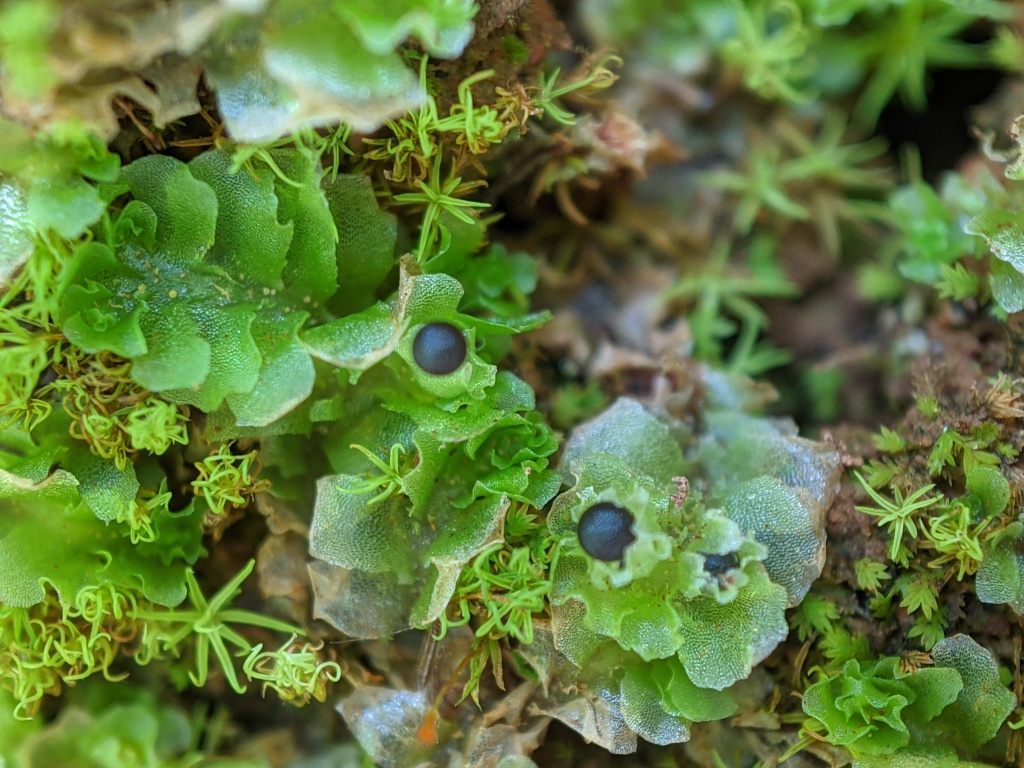Fossombroniaceae
Terrestrial, monoicous or dioicous with male and female plants a similar size. Asexual reproduction rarely by gemmae produced on adaxial lobe or caulocalyx. Tubers occasionally produced near stem apex or laterally from stem. Plants comprising a fleshy simple or sparingly furcate stem and leaf-like lobes, pale to bright green; lobes polymorphic, quadrate to rectangular in outline, entire to irregularly dissected, succubous, usually highly undulate and crisped, rarely concave adaxially and not crisped or undulate, often incurved and concealing the stem, unistratose except near base where 2–4-stratose; lobe cells quadrate, rhomboid or polygonal, thin-walled, without trigones, with 5–80 small glistening, spherical and homogenous to finely botryoidal oil bodies. Abaxial stem with foliose triangle scales near apex, hairs or stalked papillae. Rhizoids abundant along abaxial stem, without internal peg-like thickenings, usually purplish or crimson, sometimes hyaline. Antheridia scattered along adaxial stem, naked or protected by scales. Sporophytes scattered along adaxial stem, surrounded by a shoot calyptra and caulocalyx; caulocalyx campanulate or infundibuliform with flaring entire, dentate or lobed mouth, sometimes with lamellae, sessile or stipitate; pseudoperianth absent; involucre absent. Seta elongate. Capsule globose or rarely ovoid, bistratose, rarely 3–5-stratose, outer layer without cell thickenings, dehiscence irregular; elaters present, 2 or rarely 3–5-spiral. Spores globose or hemispheric with a flattened or concave proximal face, areolate, ridged or papillate to spinose, sometimes smooth and often with triradiate mark on proximal face, brown, maroon or purple, shed singly or in tetrads (not in Victoria).
One genus, Fossombronia, widespread throughout the world, but absent from Antarctica, and comprising around 100 species; 25 species in Victoria.
The spores, particularly their ornamentation, is highly variable in Fossombroniaceae, compared to the gametophyte that is relatively constant. Consequently, Fossombronia identification is highly reliant on spore morphology (see Milner et al. 2011) and only two of the Victorian species are distinct enough vegetatively to be confidently identified without spores.
The majority of species recognised here in Victoria were described in the 1980’s (Scott & Pike 1984, 1987). Several of their species are very similar to one another and to species widespread outside of Australia and yet the authors provide no keys to their species and for most species no notes on how they are distinguished from similar species. These species are recognised here with hesitation and are differentiated based on any slight differences that could be determined when comparing descriptions, spore images and the few collections identified as these species by G.A.M. Scott or D.C. Pike. The taxonomic status of these species require further investigation involving more Fossombronia collections to better assess variation present in the putative species to determine whether these possible differences are maintained when more collections are studied. Genetic differentiation between Victorian species is also poorly understood as current sampling of Fossombronia species in DNA phylogenies is still limited (Milner et al. 2011; Cargill et al. 2020) and does not include most of the Victorian species.
Cargill, D.C., Callaghan, D.A., Forrest, L.L. & Reeb, C. (2020). Fossombronia isaloensis Cargill & D.A.Callaghan, a new liverwort from sandstone massifs in southern Madagascar. Journal of Bryology 42: 213–222.
Milner, M., Sharma, I., Freire, V. & Cargill, D.C. (2011). Spore ornamentation patterns and species delimitations within Australian Fossombronia Raddi (Fossombroniaceae) populations. The Bryologist 114: 128–141.
Scott, G.A.M. & Pike, D.C. (1984). New species of Fossombronia from Australia. Journal of the Hattori Botanical Laboratory 56: 339–349.
Scott, G.A.M. & Pike, D.C. (1987). Studies on Fossombronia in Australia II fourteen more new species. Journal of the Hattori Botanical Laboratory 62: 367–386.
 Spinning
Spinning